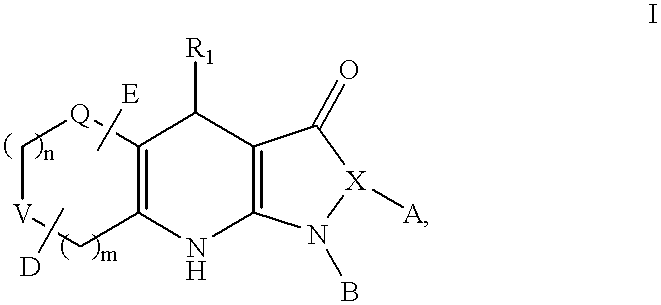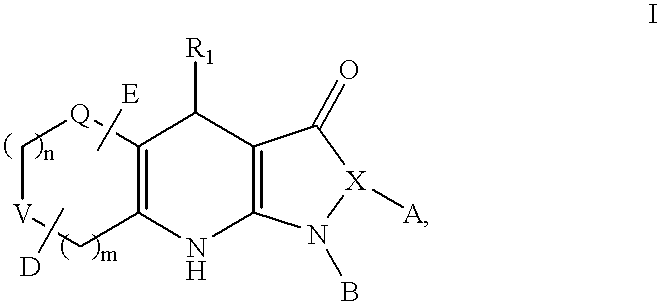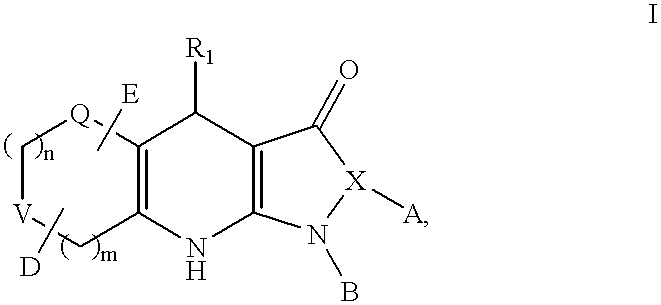Tricyclic dihydropyrazolone and tricyclic dihydroisoxazolone potassium channel openers
- Summary
- Abstract
- Description
- Claims
- Application Information
AI Technical Summary
Problems solved by technology
Method used
Image
Examples
example 2
4-(3-bromo-4-fluorophenyl)-1,2,4,6,7,8-hexahydrocyclopenta[blpyrazolo[4,3--e]pyridine-3,5-dione
[0309] 5-Amino-1,2-dihydropyrazol-3-one (0.15 g, 1.5 mmol), 3-bromo-4-fluorobenzaldehyde (0.31 g, 1.5 mmol), and 1,3-cyclopentanedione (0.15 g, 1.5 mmol) in ethyl alcohol (3 mL) were heated at 80.degree. C. for 2 days in a sealed tube. The reaction mixture was evaporated under reduced pressure and the residue was chromatographed on silica gel eluting with ethyl acetate:formic acid:water (18:1: 1) to provide 0.125 g of the title compound as a tan solid. .sup.1HNMR (300 MHz, DMSO-d.sub.6) .delta. 2.22 (t, 2H), 2.61 (m, 2H), 4.73 (s,1H), 7.15 (m, 1H), 7.2 (m, 1H), 7.4 (dd, 1H), 9.75 (s, 1H), 10.21 (s, 1H), 11.3 (bs, 1H); MS (ESI-) m / z 362 (M+H).sup.-; Anal. calcd for C.sub.15H.sub.11N.sub.3BrFO.sub.2.0.5H.sub.2O: C, 48.28;H, 3.24; N, 11.26. Found: C, 48.88;H, 3.29; N, 10.83.
example 3
4-(3-bromo-4-fluorophenyl)-4,7,8,9-tetrahydro-1H-pyrazolo[3,4-blquinoline--3,5(2H,6H)-dione
[0310] 5-Amino-1,2-dihydropyrazol-3-one (0.15 g, 1.5 mmol), 3-bromo-4-fluorobenzaldehyde (0.3 g, 1.5 mmol), and 1,3-cyclohexanedione (0.17 g, 1.5 mmol) were processed as described in Example 2 to provide 0.14 g of the title compound. .sup.1H NMR (300 MHz, DMSO-d.sub.6).delta. 1.85 (m, 2H), 2.18 (m, 2H), 2.55 (m, 2H), 4.94 (s,1H), 7.12 (m, 1H), 7.18 (t, 1H), 7.4 (dd, 1H), 9.75 (s, 1H), 10.35 (bs, 1H), 11.33 (bs, 1H); MS (ESI-) m / z 376 (M+H:).sup.- Anal. Calcd for C.sub.16H.sub.13N.sub.3BrFO.s-ub.2: C, 50.79;H, 3.44; N, 1 1.11. Found: C, 50.45;H, 3.42; N, 11.33.
example 4
4-(3-bromo-4-fluorophenyl)-1-ethyl-1,2,4,6,7,8-hexahydrocyclopentafblpyraz-olo[4,3-e]pyridine-3,5-dione
[0311] 5-Amino-1-ethyl-1,2-dihydropyrazol-3-one (0.13 g, 1 mmol ), prepared by the method of (A. Weisberger and A. Porter, J. Amer. Chem. Soc, (1944) 66,1849) from ethylhydrazine and ethyl cyanoacetate, 3-bromo-4-fluorobenzaldehyde (0.2 g, 1 mmol), and 1,3-cyclopentanedione (0.1 g, 1 mmol) in ethyl alcohol (2 mL) were heated at 80.degree. C. for 2 days in a sealed tube. The reaction mixture was cooled and the resulting precipitate was filtered off to provide 0.23 g (58%) of the title compound as a tan solid. .sup.1H NMR (300 MHz, DMSO-d.sub.6).delta.1.22 (t, 3H), 2.28 (t, 2H), 2.68 (m, 2H), 3.82 (q, 2H), 4.7 (s, 1H), 7.17 (m, 1H), 7.2 (t, 1H), 7.4 (dd, 1H), 9.64 (bs, 1H), 10.4 (s, 1H); MS (ESI-) m / z 392 (M+H:).sup.-, Anal. calcd for C.sub.17H.sub.15N.sub.3BrFO.sub.2.0.5H.sub.2O: C, 50.89;H, 4.02; N, 10.47. Found: C, 50.85;H, 3.72; N, 10.25.
PUM
| Property | Measurement | Unit |
|---|---|---|
| Fraction | aaaaa | aaaaa |
| Fraction | aaaaa | aaaaa |
| Fraction | aaaaa | aaaaa |
Abstract
Description
Claims
Application Information
 Login to View More
Login to View More - R&D
- Intellectual Property
- Life Sciences
- Materials
- Tech Scout
- Unparalleled Data Quality
- Higher Quality Content
- 60% Fewer Hallucinations
Browse by: Latest US Patents, China's latest patents, Technical Efficacy Thesaurus, Application Domain, Technology Topic, Popular Technical Reports.
© 2025 PatSnap. All rights reserved.Legal|Privacy policy|Modern Slavery Act Transparency Statement|Sitemap|About US| Contact US: help@patsnap.com



